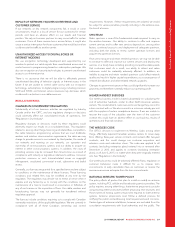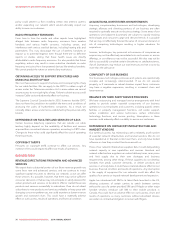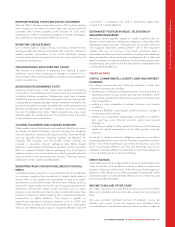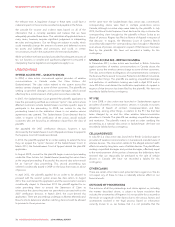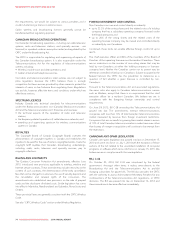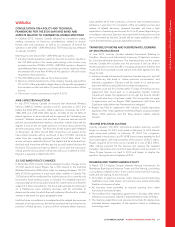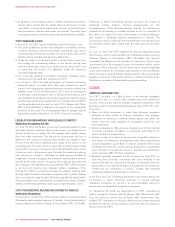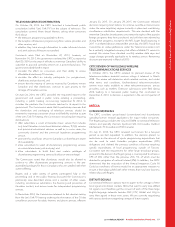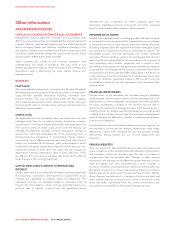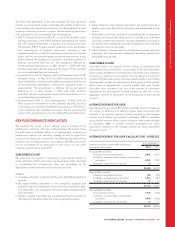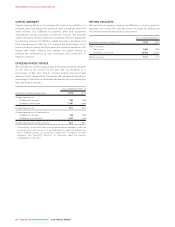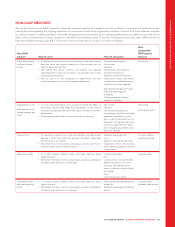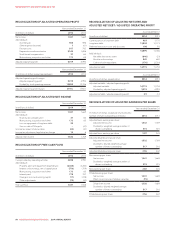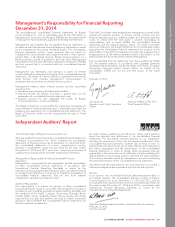Rogers 2014 Annual Report Download - page 81
Download and view the complete annual report
Please find page 81 of the 2014 Rogers annual report below. You can navigate through the pages in the report by either clicking on the pages listed below, or by using the keyword search tool below to find specific information within the annual report.
MANAGEMENT’S DISCUSSION AND ANALYSIS
TELEVISION SERVICES DISTRIBUTION
On October 24, 2013, the CRTC launched a broad-based public
consultation (called “Let’s Talk TV”) on the subject of television. The
consultation covered three broad themes, asking what consumers
think about:
• the television programming available to them;
• the reception of television programming from service providers and
other sources; and
• whether they have enough information to make informed choices
and seek solutions if they are not satisfied.
Comments were filed on November 22, 2013, however, on
November 14, 2013, the government ordered the CRTC to report by
April 30, 2014 on the steps it will take to maximize Canadians’ ability to
subscribe to pay and specialty services on a pick-and-pay basis. The
government asked that the report:
• consider the effect on consumers and their ability to access
affordable discretionary TV services;
• consider the effect on industry participants (i.e. programmers,
distributors and producers); and
• ensure that the majority of services received by Canadians remain
Canadian and that distributors continue to give priority to the
carriage of Canadian services.
On April 24, 2014, the CRTC provided the requested report to the
government and issued a public notice initiating a proceeding,
including a public hearing commencing September 8, 2014, to
consider the positions the Commission reached in its report to the
government. The Commission wrote that its preliminary view was that
the distribution and packaging of television services should be
reviewed to maximize consumer choice and flexibility and that as part
of the Let’s Talk TV hearing, the Commission would explore requiring
distributors to:
• offer subscribers a small, all-Canadian basic service that includes
only local Canadian conventional television stations, 9(1)(h)services
and provincial educational services, as well as, in some cases, the
community channel and the provincial legislature programming
service;
• promote this small basic service to Canadians so that they are aware
of its availability;
• allow subscribers to select all discretionary programming services
on a stand-alone basis (pick-and-pay); and
• allow subscribers to build their own custom packages of
discretionary programming services (build-your-own-package).
The Commission noted that distributors would also be allowed to
continue to offer discretionary programming services in the pre-
assembled packages for those Canadians who are satisfied with their
current offering.
Rogers and a wide variety of parties participated fully in the
proceeding and at the public hearing discussed the Commission’s
preliminary view described above and a number of other issues,
including simultaneous substitution, the financing and promotion of
Canadian content, and access issues for independent programming
services.
In November 2014, the Commission released its first decision arising
from the Let’s Talk TV hearing ordering the elimination of the 30-day
cancellation provision for cable, Internet, and phone services, effective
January 23, 2015. On January 29, 2015, the Commission released
decisions requiring local stations to continue over-the-air transmission
under the same regulatory regime currently in place and maintaining
simultaneous substitution requirements. This was decided with the
intent that Canadian broadcasters can protect the rights of the popular
foreign programs they have purchased and sell their own advertising
during these programs, except for the NFL Super Bowl beginning in
2017. In a related decision released the same day, the CRTC found that
it would be an undue preference under the Telecommunications Act
for a vertically integrated company that offers a Mobile TV service to
exempt this service from standard monthly wireless data caps and
usage charges generally applicable to its wireless service. Remaining
decisions are expected in March of 2015.
CRTC REVIEW OF WHOLESALE WIRELINE
TELECOMMUNICATIONS SERVICES
In October 2013, the CRTC initiated its planned review of the
telecommunications essential services rulings it released in March
2008. The review will determine which wireline services, and under
what terms and conditions, facilities-based telecommunications
carriers must make available to other telecommunications service
providers, such as resellers. Extensive submissions were filed during
2014 leading to a two-week public hearing that concluded on
December 4, 2014. A decision is expected in the second quarter of
2015.
MEDIA
LICENCE RENEWALS
The CRTC considers group-based (conventional and discretionary
specialty) licence renewal applications for major media companies.
The Rogers group includes the City and OMNI conventional television
stations and specialty channels Sportsnet 360, G4 Canada, Outdoor
Life Network, FX (Canada) and FXX (Canada).
On July 31, 2014, the CRTC renewed our licences for a two-year
period as we had requested. In addition, the decision placed no
restrictions on the amount of sports programming expenditures that
can be used to meet Canadian program expenditures (CPE)
obligations and deleted the previous condition of licence requiring
specific expenditures of local programming outside of Toronto.
Consistent with the requirement for other large broadcast groups,
pursuant to the decision the Rogers group is now required to achieve a
CPE of 30% rather than the previous 25%, 5% of which must be
directed to programs of national interest (PNI). In addition, the CRTC
determined that the imposition of the Vertical Integration Code (VI
Code) as conditions of licence would be an appropriate measure to
ensure a level playing field with other entities that may have business
relationships with Rogers.
DISTANT SIGNALS
Conventional television stations have to agree to the carriage of their
local signals into distant markets. BDUsthatwanttocarrytime-shifted
US signals must therefore get the consent of each of the three large
English-language networks besides CBC (CTV, Global and City) to
carry their signals in those time zones. We are currently negotiating
with various distributors regarding carriage of distant signals.
2014 ANNUAL REPORT ROGERS COMMUNICATIONS INC. 77




